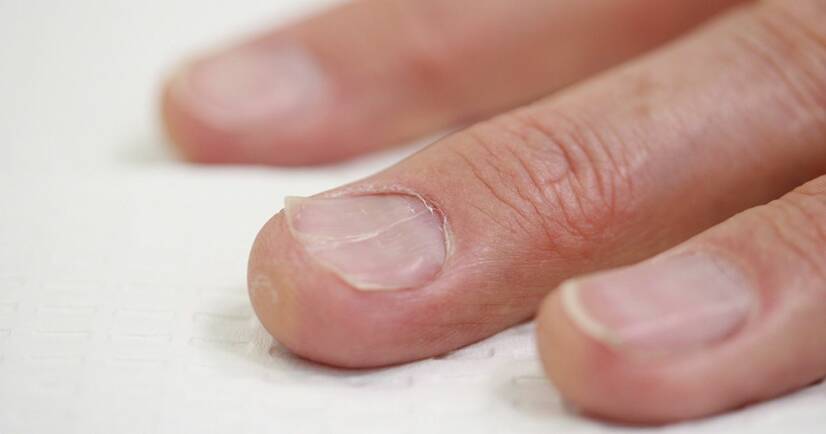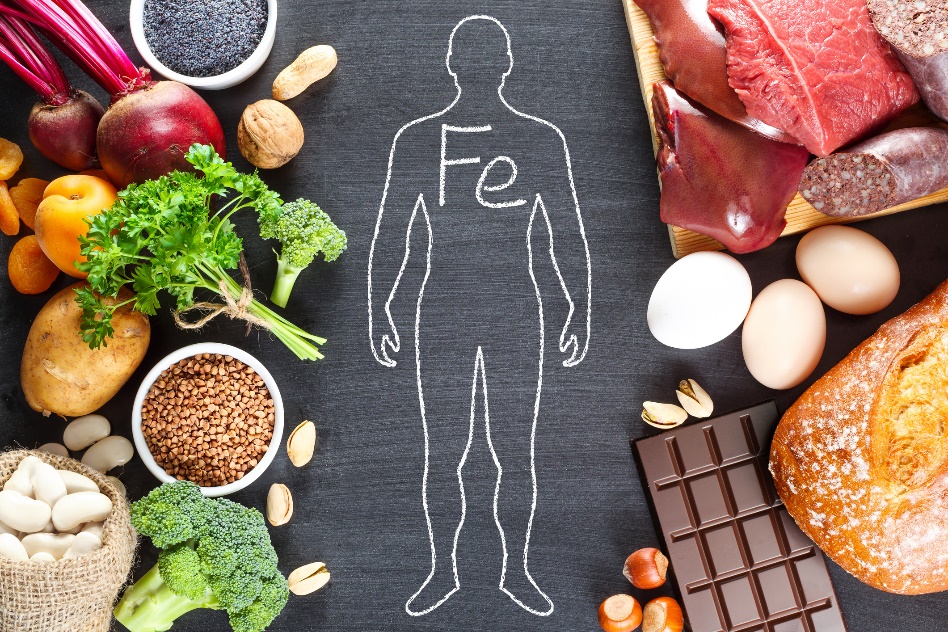- medicalnewstoday.com - Koilonychia: Why do I have spoon-shaped nails? Medical News Today. Debra Rose Wilson, Ph.D., MSN, R.N., IBCLC, AHN-BC, CHT
- dermatologypropraxi.com - Diseases and pathologies of the nails. Dermatology for practice. Alena Štumpfová, M.D.
- healthline.com - Spoon nails (koilonychia). Healthline. Debra Sullivan, Ph.D., MSN, R.N., CNE, COI
- TŘEŠŇÁK HERCOGOVÁ, Jana. Clinical Dermatovenerology. Prague: Institute for Health Care of the People: Mladá fronta, 2019. Health Services. ISBN 978-80-204-5321-1
- solen.cz - Diseases of the nails. Solen. MUDr. Helena Korandová, CSc.
Ingrown nails: why do they arise? Diagnosis and treatment

Ingrown nails are also known as spoon-shaped nails. They can indicate various disorders, both local and general. It is a pathological shape of the nail plate. What are the causes of ingrown nails?
Ingrown nails are characterised by a sunken centre and an upward curved end. Healthy nails have an oval shape that follows the shape of the finger.
With spoon-shaped nails, there is a spoon-shaped depression in the middle of the nail. If a person has this shape of nails, it may indicate iron deficiency, mycotic nail disease, mechanical damage or other disorders in the body.
Healthy and unhealthy nails
In general, the nails should have a soft pink color, natural length and their surface should be free of cracks, color spots and other deformities (waves, grooves, pits...).
The nail is a hard keratin plate covering the ends of the fingers and toes. The nail is physiologically composed of the nail matrix (the root of the nail), the lunula (a crescent of lighter colour), the cuticle (the nail cuticle), the nail bed and the nail plate itself.
Ingrown nails are technically referred to as koilonychia.
In addition to resembling a spoon, the nails tend to split and break due to a weakening of the overall quality of the nail plate.
The condition of the nails depends on a number of factors:
- Age
- Overall health and diagnosis
- Local nail disease (mycosis)
- Lifestyle (diet, stress)
- Adequate nutrient intake (vitamins, minerals, protein)
- Nail care (manicure, pedicure, nutrition, protection)
- Mechanical damage (work, sport, injury)
Etiology and causes of ingrown nails
Spoon-shaped nails are professionally referred to as koilonychia. This condition can be the result of mechanical damage, local nail disease or some internal disease of the body.
Koilonychia is primarily associated with a deficiency of the mineral iron.
Mycotic nail disease
Fungal mycotic diseases most commonly cause a change in the quality, shape or colour of the nail. Fungal diseases can occur on the skin as well as on the nails of the hands and feet.
There are several types of fungi, such as dermatophytes, yeasts, molds or micromycetes.
These are infectious microorganisms that attack the nails, damaging their surface, quality and appearance. The nails may be weakened, brittle, bent or in some cases dented. The weakening of the nail structure leads to breakage, splitting and rarely to deepening and curving.
Iron deficiency and nutrient deficiency
Iron is one of the essential minerals for the proper functioning of the body, especially for the production of hemoglobin and erythrocytes (red blood cells). Iron deficiency can cause anemia.
In addition, ingrown toenails are associated with a deficiency of vitamins B and C.
If the level of hemoglobin (the red blood pigment that binds oxygen) is reduced, the level of red blood cells themselves is reduced. There is insufficient blood supply and supply to the tissues.
The nails are weak, brittle and brittle as a result of anaemia. They have a concave, spoon-shaped appearance. The nail plates are sunken in the middle.
Excessive fatigue, general weakness, shortness of breath and frequent dizziness are also symptoms of severe iron deficiency.
Iron is one of the most commonly missing minerals in the body. This condition can result from a lack of iron in the diet or the body's inability to absorb iron.
The cause may be excessive iron loss or hemochromatosis, i.e. excessive iron deposition in the liver.
In conjunction with inadequate nutrition, various digestive tract diseases and intestinal inflammation are involved, in which the absorption of nutrients into the body is impaired.
Read also:
Nonspecific intestinal inflammation, IBD: What are the types and symptoms?
Cardiovascular disease
Changes in the nails can occur when the blood supply to peripheral parts of the body is impaired in various cardiovascular diseases such as ischemic lower limb disease (IHD) or Raynaud's syndrome.
Autoimmune diseases
Some autoimmune diseases can manifest themselves in skin conditions and skin derivatives. Examples are lupus, lichen planus, rheumatoid arthritis, scleroderma or psoriasis.
Diseases of the thyroid gland
Hypothyroidism and hyperthyroidism are disorders of the thyroid gland. They involve changes in the production and levels of the hormones thyronine and thyroxine, which are of broad importance to the body. Hormonal imbalances can cause changes in the quality and shape of the nails.
Changes and decreases in the levels of these hormones cause fatigue, muscle weakness, risk of atherosclerosis, digestive disorders, changes in metabolism and body weight.
The quality of skin and hair is also affected. As the disease progresses, the nails may also weaken. They become brittle, weak and in some cases dented.
When do I need to see a doctor?
Ingrown nails are a symptom that should not be overlooked. It does not have to be anything serious. But whether the change in nail structure is due to a local or general disorder, a professional diagnosis by a doctor is necessary.
Visit a dermatologist in case of nail changes and imperfections that are acute, worsen or persist for a long time.
If you are experiencing other general physical symptoms, it is advisable to see a GP. The doctor will also refer you to the appropriate department.
Diagnosis and treatment of koilonychia
The initial diagnosis of coilonychia is made in most cases by a dermatologist. The dermatologist will examine the damaged nail locally. A scraping of the nail tissue will confirm or rule out the presence of infection.
In the case of koilonychia, the doctor indicates a blood draw and blood count to determine the level of red blood cells, the concentration of iron and other important nutrients.
If an internal disease is suspected, the dermatologist will refer the patient to the appropriate department. If a thyroid disorder is suspected, for example, blood tests for hormonal balance and other necessary endocrinological examinations will be carried out.
The treatment of koilonychia depends on the exact cause of its occurrence. The treatment plan is therefore individual for each patient.
With a mycotic infection of the nails, the doctor will prescribe antifungal treatment in the form of topical preparations or oral complex antifungal drugs.
Iron supplementation is indicated when the blood count is impaired. More iron should be taken from the normal diet, but also through supplements. Natural sources of iron include mainly red meat, beans, leafy vegetables, eggs or cereal products, etc.
For other endocrine or metabolic diseases, the primary treatment is aimed at eliminating the cause of the disease and at eliminating (alleviating) the unwanted symptoms.
Examples of natural sources of iron in the diet:
- Meat (red meat)
- Fish and seafood
- Vegetables (broccoli, spinach, lettuce)
- Nuts and seeds
- Eggs
- Cereals (quinoa)
- Legumes (beans, peas, chickpeas)
- Dark chocolate

Nail health
Diet and nutrition affect the quality of your nails, hair and skin. Therefore, it is advisable to follow a nutritionally balanced diet and try proven dietary supplements where appropriate.
Intake of protein, zinc, selenium, iron and vitamin B (B-complex) is important for nail and hair health.
Gentle regular care (manicures, pedicures), limiting irritants and hand hygiene are essential to prevent nail infections.
Topical protective and nourishing medications or cosmetic products can be used to improve the quality of the nails. However, consultation with a doctor is essential, especially in the case of nail infections.
Prevention of healthy nails:
- A healthy and nutritionally balanced diet
- Adequate intake of mineral iron
- Sufficient zinc, selenium, silicon and calcium
- Sufficient vitamins A, B C, D and E
- Adequate dietary protein intake
- Regular gentle care
- Disinfection of cosmetic instruments
- Hand hygiene to prevent infections
- Reduction of irritants and adhesives
- Nail support and nutrition with proven products
- Protecting nails from risky activities
- Visiting a doctor when health problems occur
Diseases with symptom "Deepened nails"
Interesting resources
Related










